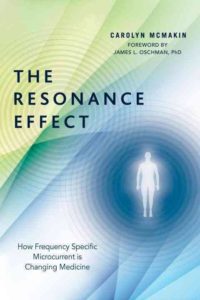The Resonance Effect, How Frequency Specific Microcurrent is Changing Medicine
 The “Resonance Effect” by Carolyn McMakin
The “Resonance Effect” by Carolyn McMakin
Excerpts from the review:
Chiropractic doctor Carolyn McMakin’s book “The Resonance Effect” – North Atlantic Books – adds an interesting dimension to the hidden in plain sight world of microcurrent. According to the author, this could possibly be the way to change the face of medicine with Frequency Specific Microcurrent (FSM). McMakin’s book subtitle “The Resonance Effect, How Frequency Specific Microcurrent is Changing Medicine” is interesting. It somehow implies that the physics of resonance easily translate into healing for her and her clients.
Branding her kind of microcurrent as “frequency specific” sparks interest, especially in regards to recent advanced microcurrent Russian research. As a result, this seems timely and a great reason to read this book review. The notion of using specific frequencies for specific ailments is very compelling. Some form of electrotherapy having been around for thousands of years. In the 1920s, the West favored pharmaceuticals and disavowed electrotherapy. However, the author’s emphasis on frequencies may delude us. One of her claims is that even with the simplest microcurrent device you can have the same stupendous results as everyone should know and understand.
Let’s be practical here. A total medical reset is necessary across the planet. The questions are numerous. But, is McMakin’s work the only representative of the most up to date research in microcurrent, or simply a rehash of the other electrotherapy from bygone years? And what about the millions currently funded by the pharmaceuticals with microcurrent implants?
A look at the history of electrotherapy
McMakin’s hardly mentions the other volumes of research that has been accomplished in the worldwide. So, lets fill in that gap right now. The history of electrotherapy shows that electrotherapy goes back a long way in history. Possibly originating from thousands of years in the Orient, to second emperor of Rome Numa Pompilius who built himself an electricity lab. Furthermore, it was used in ancient Rome of shallow ponds with electric eels to cure depression and lethargy.
Maybe like Numa Pompilius had found already, in the 1880’s batteries created a dependable source of electricity which made electrotherapy thrive in the early 1900. However, what happened to it? As a result, what makes Google tell us only about “funky looking electrical equipment that fell out of use in the 1940?”
The author gives an answer. All blame goes to the above mentioned Flexner Report. In fact, as early as 1910, it began to streamline medicine into a corporate moneymaking enterprise. Eventually, it outlawed electrotherapy devices, (and squashing not only electrotherapy but everything non pharmaceutical or “alternative”, then in use, “like homeopathy”), in favor of surgeries and drugs. In addition to this, it forbidded doctors to use electricity for healing. As a result, this forced electrotherapy to go underground and creating a huge disconnect….
If you want to know more about the resonance effect and gain more knowledge about the latest in FSM microcurrent, read our full book review here.
Get started with your best health journey today. Click here for your personalized health report from eBodyFUSION.